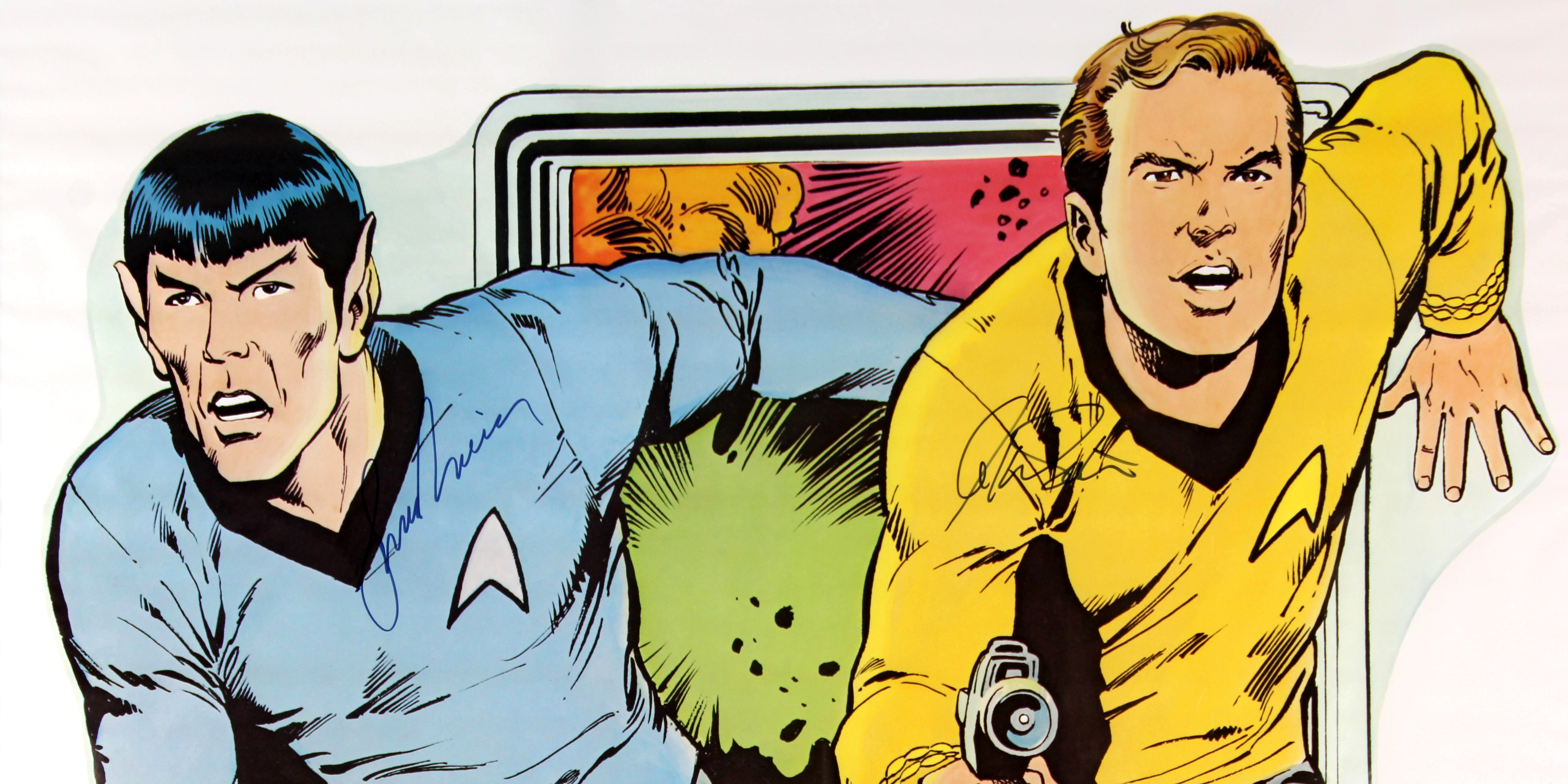I own all the mainstream Star Trek original-series comics but some of the lesser-known books are not on my shelves. Then I was reminded recently that many Peter Pan records came with comic books, and it suddenly bothered me that I had none of those.
To eBay! I picked up two book-and-record sets for C$18 each, still sealed in plastic. I am writing about one of those here.
(A small aside: there are a ton of Star Trek comics and comic strips and as far as I know only two people own all the US and UK English-language instances: Rich Handley and Mark Martinez.)

A quick history: Peter Pan and Power Records
Peter Pan Industries produced records for kids under the brand names Peter Pan and Power Records. The recordings were dramatic performances of original stories, with music and sound effects. The company’s tales featured many TV shows, including The Six Million Dollar Man and Kojak, and a bunch of superheroes and cartoon characters. It also produced 11 original Star Trek stories between 1975 and 1979 and packaged and repackaged them across more than 20 33-1/3 and 45 RPM discs. Ten of those sets included colourful read-along comic books.
My recent acquisitions include the 1976 LP that published The Time Stealer and republished A Mirror for Futility, originally released in 1975 although apparently without the comic that accompanied the later release. (Honestly, the permutations of story and comic releases are headache inducing.)
The artwork is dynamic and quite true to the show — except when it isn’t at all. For example, Sulu is depicted as a black man wearing science blue and Uhura is a white woman with very blond hair. A Star Trek fan named Clay Arden told me that he asked Neal Adams, a frequent Peter Pan artist, about this. Adams said the depictions were intentional, as the company had only licensed the likenesses of William Shatner, Leonard Nimoy and DeForest Kelley.


Here are the two stories, both the audio and the comics. You can start the audio playing and click through the scans along with the story — just as you were meant to do in 1976 with the record and the comic.
A Mirror for Futility
This is the better of the two stories. It was written by Alan Dean Foster, a prolific author who also penned the Star Trek Log animated-series adaptations, and drawn by Adams, who also created my favourite Star Trek poster.
The Time Stealer
The Peter Pan stories were written and drawn for kids, so you have to expect some silliness. Even so, the two antagonists here look exactly like Conan the Barbarian and Merlin, and the plot relies on Spock using magic and the Enterprise computers to project the “mental images” of millions of dead people — or something. Oh, and Kirk tries to shoot a possibly sentient being with the ship’s phasers. This one was written by Cary Bates and Neal Adams.
I also own the 1979 LP that features the stories The Crier in Emptiness and Passage to Moauv but uses photos from The Motion Picture on the front and back covers even though the comics are set in the TOS era. I wrote about that one here.



















10 responses to “Join me for two Trek tales from Peter Pan Records”
I have a few of these. Two are the 12 inch like the first one in your post. I found one on Marketplace that was still in plastic. I put it in a record frame. I have some of the TMP branded 7″ records as well. Really cool stuff. One of the subsets of my collection is Star Trek vinyl so I really enjoyed this post. One of my prize pieces in my Trek vinyl is a 45 rpm version of the Main Title to The Wrath of Khan in original sleeve.
LikeLike
I picked up a number of records over the years but I have only recently started taking Star Trek vinyl more seriously. I am sure I have some work to do to catch up with you.
LikeLike
That TWOK 45 has a unique edit of the main and end titles. It was released on the latest Trek II CD from La-La Land Records.
https://lalalandrecords.com/star-trek-ii-the-wrath-of-khan-limited-edition-2-cd-set/
LikeLiked by 1 person
I don’t have that vinyl but I do own the La-La Land CD, of course.
LikeLike
“The Time Stealer” was written by Cary Bates & Neal Adams.
Alan Dean Foster is credited with writing the following: “To Starve a Fleaver,” “The Logistics of Stampede,” and “A Mirror for Futility.”
This album cover credits them: https://www.ebay.com/itm/165911859151?hash=item26a11e0fcf:g:uLAAAOSwhfBjwBcG&amdata=enc%3AAQAHAAAAsK398QhJDSy%2BxC0pBjMR0U%2B7sudTqHXBligatCrOjiVgNkOvwS%2FVx%2Bujezh%2BlyLFP6Mlk1QXkSmPBr3br7Wo1Flx2piyZ0BiBCcpcQRGh07u8eurqMEgztpq2ihxBXe219cLg9XD3ecGqQZHWUWzzmIIpUeK3c4cX0bR2MiRyT9ltQRADDcopJSt3FuCa%2B3QQpnI4s2bd7yFHyKhRYPvznYKt%2FjRoJWbjkuj8RnLQLmx%7Ctkp%3ABk9SR_i1ufDPYQ
LikeLiked by 1 person
Thank you! I will revise the piece.
LikeLike
I’ve been told over the years that part of the reason for the race switched Uhura and Sulu were actor likeness rights issues. It seems likely, since images of the Star Trek cast were pretty easy to find in the mid seventies and it’s hard to believe that the artists were completely unaware of the actors ( particularly since in one comic – “Passage To Moauv” I believe there is a perfect likeness of Nichelle Nichols in one panel…except for the coloring ).
LikeLike
A Trek fan named Clay Arden just told me this on Facebook: When I met Neal Adams, he confirmed to me that Sulu and Uhura were depicted differently on purpose, because the company only had a license to use the likenesses of Shatner, Nimoy, and Kelley.
So it seems that the story you heard is true. And I looked at the artwork in Moauv and I think Uhura pretty much looks the same as in these two comics.
LikeLike
The illustration of Uhura on page 12 of “Passage To Mouav” bears an uncanny resemblance to Nichelle Nichols.
LikeLike
[…] Collectingtrek.ca has added a new review for ‘s “Star Trek Book & Record Set”: […]
LikeLike